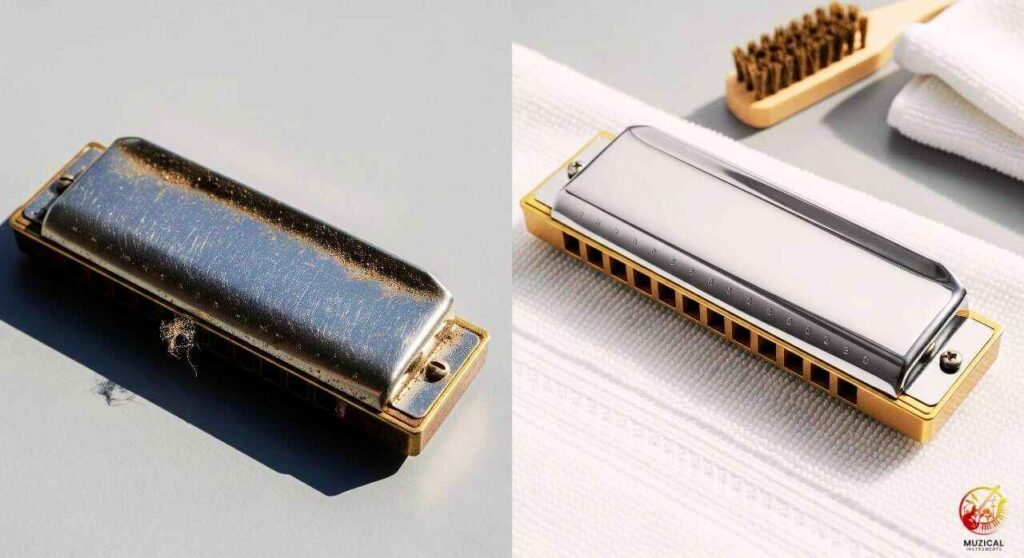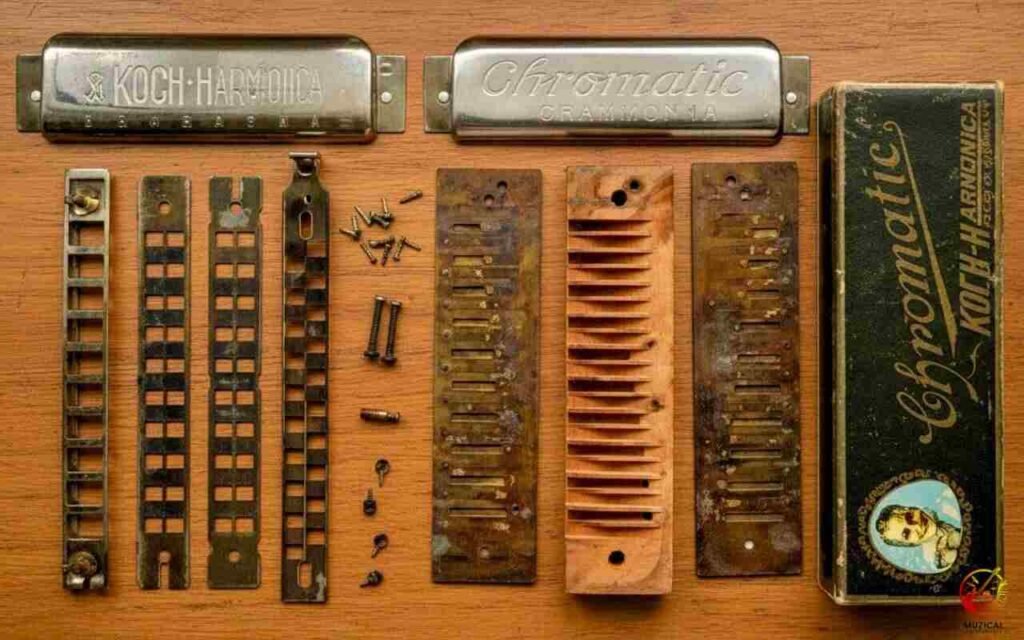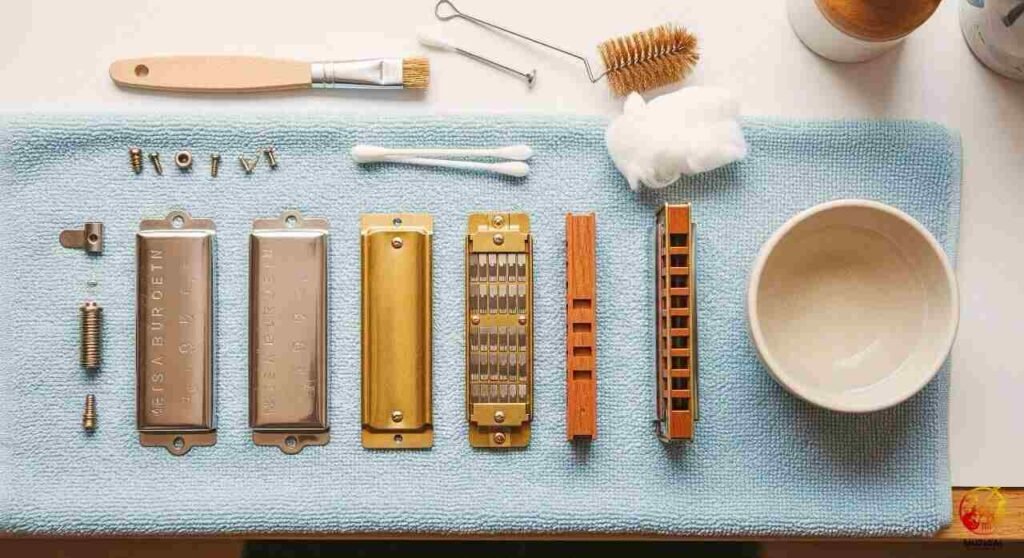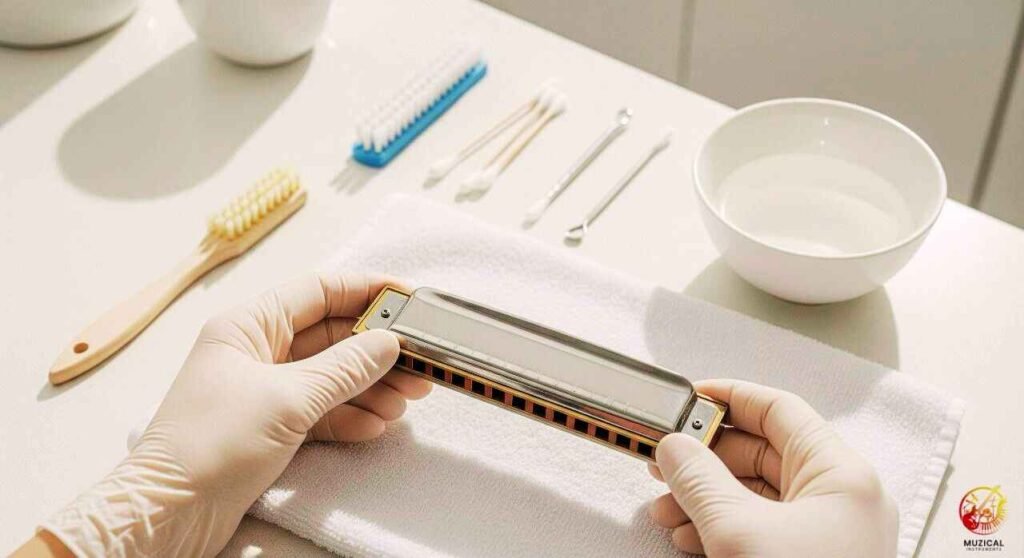How to Sterilize a Used Harmonica Without Hazards
How to sterilize a used harmonica is something you need to know before playing it. These used instruments harbor dangerous bacteria and viruses in their reed chambers.
When you buy secondhand harmonicas from music stores, online marketplaces, or estate sales, you risk exposing yourself to oral infections, respiratory diseases, and cold sores from previous owners. Many musicians unknowingly contract these illnesses because they skip proper sanitization steps.
This guide teaches you safe, proven methods to eliminate harmful germs without damaging your instrument. You’ll learn the difference between basic cleaning and medical-grade sterilization, plus discover which chemicals work best for different harmonica types.
Whether you’re buying vintage Hohner harmonicas, sharing instruments in a music classroom, or cleaning rental equipment, these techniques keep you healthy while preserving sound quality.
What’s the Real Risk? Can You Get Sick from a Used Harmonica?

Let’s get straight to the point: yes, you can get sick from playing a dirty harmonica. A harmonica’s warm, damp insides are the perfect home for germs. Saliva can carry all sorts of things you don’t want, like bacteria that cause strep throat, the common cold, the flu, and even the virus that causes cold sores. While many of these germs die as the instrument dries, the risk never goes away completely without a proper cleaning.
It’s also important to know the difference between cleaning and sterilizing.
- Cleaning means scrubbing off the visible dirt and old saliva.
- Sterilizing means killing all the invisible germs, the bacteria and viruses.
For a used harmonica, you want to do more than just clean it. You want to sterilize it. Rinsing it under the tap won’t cut it. Your goal is to make it as germ free as a brand new instrument. The good news is that this is totally possible to do at home.
Why You Must Disassemble Your Harmonica to Clean It
For a quick wipe down after you play, you don’t need to take your harmonica apart. But for that first deep sterilization of a used harmonica? You absolutely must disassemble it.

The most important parts, the reeds that make the sound, are hidden inside. There is no way to get them truly clean without taking the cover plates off. All sorts of gunk gets trapped between the reed plates and the comb, which is both unhygienic and bad for the sound. A dirty reed can buzz, get stuck, or stop playing entirely.
The idea of taking apart your harmonica might sound scary, but for most standard 10 hole diatonic harmonicas like a Hohner Special 20 or a Lee Oskar, it’s very easy. All you usually need is a tiny screwdriver. It’s a simple sandwich: two cover plates on the outside, two reed plates with the reeds, and the main body, called the comb.
Expert Insight: Before you undo the first screw, take a quick photo with your phone. It’s a great visual guide for putting it all back together. Place the tiny screws in a small bowl or a magnetic tray so they don’t get lost. Remember which reed plate was on top and which was on the bottom.
This simple step is the foundation of how to sterilize a used harmonica the right way.
How to Sterilize a Used Harmonica with a Plastic or Metal Comb
If your harmonica has a plastic or metal comb, you’re in luck. These materials don’t soak up water, so you can give them a very thorough cleaning without worrying about damage. Once you have the five pieces apart (two covers, two reed plates, and the comb), you’re ready to go.

This process is the core of how to sterilize a used harmonica made from modern materials.
Step-by-Step Sterilization for Plastic/Metal Combs
| Step | Action | Key Consideration |
|---|---|---|
| 1. Initial Scrub | Use a soft toothbrush with a little dish soap and warm water to gently scrub the cover plates and the plastic comb. | Get rid of any visible grime. Pay attention to the holes in the comb and the corners of the covers. Rinse everything well with clean water. |
| 2. Reed Plate Rinse | Gently rinse the reed plates under lukewarm water. Do not brush the reeds. They are very fragile and can easily bend or break. | Let the running water wash away any loose bits. This is just a prep step before the main event. |
| 3. Sterilization Soak | Place all the parts in a bowl of 70% isopropyl alcohol for about 30 minutes. You can also use 3% hydrogen peroxide, but alcohol dries faster. | Don’t use 99% alcohol. The 30% water in the 70% solution is what helps the alcohol get inside and kill the germs. It’s actually a much better disinfectant. |
| 4. Final Rinse | After the soak, rinse every piece very well under cool, clean water. This washes off any leftover alcohol. | |
| 5. Dry Everything | Lay all the parts on a clean towel to air dry. Make sure they are 100% dry before reassembly. You can use a hairdryer on the cool, low-speed setting to help. | Moisture is the enemy of a harmonica. Even a single drop of water left on a reed can cause rust. Patience here is key! |
By following these steps, you can safely sterilize a used harmonica and get it ready to play again.
What’s the Safest Way to Clean a Wooden Comb Harmonica?
This is where you need to be extra careful. Many classic harmonicas, like the famous Hohner Marine Band 1896, have a wooden comb. Wood gives a beautiful, warm sound, but it swells and warps if it gets too wet. You cannot soak a wooden comb in water or alcohol. It will ruin the harmonica forever.

So, what’s the best way to sterilize a used harmonica with a wooden comb? The secret is to use as little liquid as possible.
First, take the harmonica apart. The metal cover plates and reed plates can be cleaned and sterilized just like we discussed above, give them a good soak in alcohol. The wooden comb needs special treatment.
- Dry Clean First: Use a soft, dry brush (a clean toothbrush works great) to gently brush any dust or debris out of the comb’s channels.
- The Light Wipe Down: Get a clean cloth and put a tiny amount of 70% isopropyl alcohol on it. The cloth should be just damp, not wet. Quickly wipe down all the surfaces of the wooden comb. The alcohol will kill surface germs and then evaporate very fast before the wood can absorb it.
- Air Dry: Let the comb sit and air dry for a few minutes. It won’t take long since you used so little liquid.
This is the only safe way to sanitize a wooden comb without destroying it.
Cleaning Method Comparison: Wood vs. Plastic/Metal Combs
| Component | Plastic/Metal Comb Method | Wooden Comb Method | Why the Difference? |
|---|---|---|---|
| Cover Plates | Soap/water scrub, alcohol soak. | Soap/water scrub, alcohol soak. | Both are typically made of metal and are not damaged by liquids. |
| Reed Plates | Alcohol or peroxide soak. | Alcohol or peroxide soak. | The brass or bronze reed plates are safe to soak. The key is thorough drying. |
| Comb | Soap/water scrub, alcohol soak. | Dry brushing followed by a quick wipe with a lightly alcohol-dampened cloth. NO SOAKING. | Wood is porous and swells dramatically when exposed to moisture, causing permanent damage. Plastic and metal are non-porous. |
What Cleaning Methods Should You Absolutely Avoid?
You can find some really bad advice online about cleaning harmonicas. Using the wrong method can completely wreck your instrument. Please, never do any of the following:
- Boil it in water: This will destroy the harmonica. The heat will warp the comb and ruin the delicate tuning of the reeds.
- Use bleach or harsh cleaners: Bleach will eat away at the metal parts and leave behind poison that you don’t want to breathe or put in your mouth. Stick with isopropyl alcohol.
- Put it in the dishwasher: The high heat and strong detergents will tear your harmonica apart.
- Soak the harmonica without taking it apart: This is a big mistake. It traps water inside where it can’t dry, causing the reeds to rust. It also doesn’t clean the instrument properly.
Knowing what not to do is just as important as knowing the proper technique for how to sterilize a used harmonica.
Final Thoughts: Bringing It All Back Together
After you have carefully cleaned, sterilized, and dried all the pieces, it’s time to put your harmonica back together. Just work backward, carefully screwing the covers back onto the comb and reed plates. Make the screws snug, but don’t force them.
Your reward is a clean, safe instrument that sounds better than ever. Knowing how to sterilize a used harmonica is a skill that saves you money and gives you the confidence to play any instrument.
A clean harmonica doesn’t just protect your health; it plays more smoothly and sounds brighter. You’ve brought it back to life and made it truly your own.
FAQ: How to Sterilize a Used Harmonica
1. How often should I clean my harmonica?
For regular maintenance, it’s a good habit to gently tap out saliva after each time you play and wipe the outside with a clean, dry cloth. A deep, full sterilization like the one described in this article should be done immediately for any used harmonica you acquire. For your own harmonicas, a deep clean every few months is a great way to keep them playing their best.
2. Is it safe to share a harmonica after it has been sterilized?
Once a harmonica has been properly disassembled and sterilized using 70% isopropyl alcohol, it is hygienically safe to play, as safe as a brand-new one. However, as a general rule, most harmonica players avoid sharing their instruments to prevent the quick transfer of germs from day to day use.
3. Can I really not clean my harmonica without taking it apart?
For a true sterilization, you must take it apart. While you can wipe the outside covers, you cannot reach the inner surfaces of the reeds and comb where most germs and buildup hide. A full disassembly is the only way to ensure every part of the instrument is properly cleaned and made safe to play.
4. What is the best alcohol to use for sterilizing a harmonica?
The best and safest option is 70% isopropyl alcohol. It is more effective at killing germs than 99% alcohol because the water content helps it break down microbial cells. Never use drinking alcohol like vodka or whiskey, as they aren’t strong enough and can leave a sticky residue.
5. Will sterilizing my harmonica change how it sounds?
Yes, and almost always for the better! The process removes built-up gunk that can muffle the reeds and block airflow. After a thorough cleaning, you’ll likely find that your harmonica sounds brighter, is more responsive to your breath, and is easier to play.
6. Can I use hand sanitizer or mouthwash to clean my harmonica?
No, you should avoid both. Hand sanitizers often contain gels, moisturizers, and scents that will leave a sticky, unpleasant residue on your instrument. Mouthwash is not strong enough to properly sterilize the harmonica and contains sugars and dyes that you don’t want inside it. Stick to 70% isopropyl alcohol and water.
7. How long does the entire sterilization process take?
The hands-on work of disassembling and scrubbing only takes about 15-20 minutes. The longest part is letting the components soak in alcohol (around 30 minutes) and then waiting for them to air dry completely, which can take an hour or more. All in all, you should set aside about two hours to do the job right without rushing.
